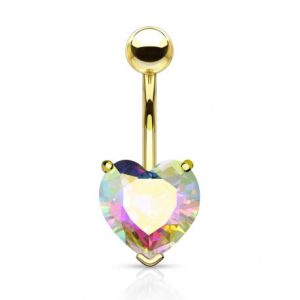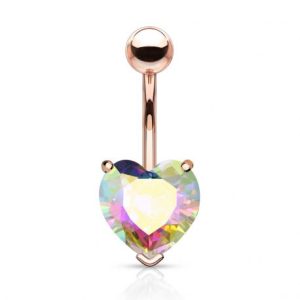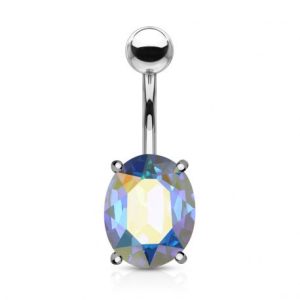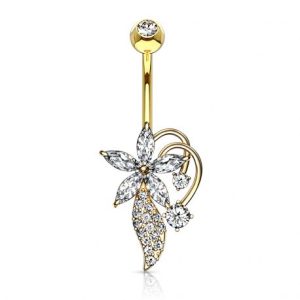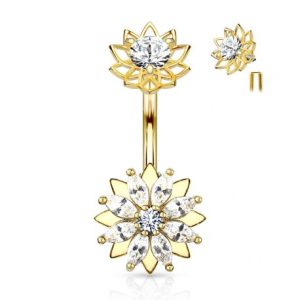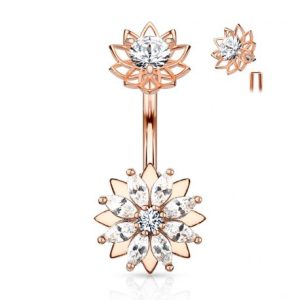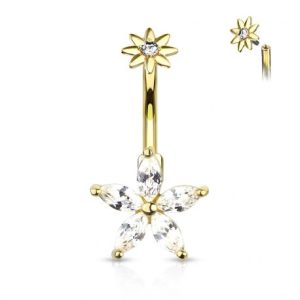Belly Piercing
Belly Button Piercing: Everything You Need to Know Before You Get One
Are you considering a belly button piercing to express your unique style? Before you take the plunge, it’s crucial to gather all the necessary information to make an informed decision. In this all-encompassing guide, we’ll delve into the captivating world of navel piercings, covering everything from their fascinating history to the various types of jewelry and essential aftercare tips. Belly button piercings have long been a sought-after form of self-expression and a fashionable accessory to one’s appearance. So, whether you’re an avid piercing fan or simply intrigued by the idea, let’s jump right in and explore everything you need to know about belly button piercings!
A Brief History of Belly Button Piercing
Belly button piercing has a rich history that dates back to ancient times. From the Egyptian Pharaohs to the Roman Empire, various cultures have adorned their navels with jewelry. The modern resurgence of navel piercing began in the 1990s, thanks in part to celebrities like Alicia Silverstone and Britney Spears, who popularized the trend.
What is a Belly Button Piercing?
Belly button piercing, also known as navel piercing, is the process of puncturing the skin around the navel to insert a piece of jewelry. The piercing can be done through the upper or lower rim of the navel, depending on the desired style. This body piercing is popular among both men and women for various reasons, including aesthetics, self-expression, and cultural significance.
Voir cette publication sur Instagram
Types of belly button piercing
There are different types of belly button piercings, such as single navel, double navel, and inverse navel piercings, each offering a unique appearance.
-
Single Navel Piercing
The single navel piercing (or belly button piercing) is the most traditional and popular type of belly piercing. It is done through the upper rim of the navel, allowing the jewelry to hang down over the belly button. The piercer will use a sterilized needle to create a small hole in the tissue above the navel and then insert the jewelry, usually a curved barbell.
- Pain Level: Moderate
- Cost:Â $40 – $70
- Healing Time: 6-9 months
This type of piercing is suitable for most individuals, as it works well with various navel shapes and sizes.
-
Double Belly Button Piercing
Double belly button piercings consist of two piercings, usually one above and one below the navel. This style offers a unique look and can be customized with various jewelry combinations. The piercer will create two separate holes, one through the upper rim of the navel and the other through the lower rim. Both piercings can be done at the same time or separately, depending on your preference and healing ability.
- Pain Level: Moderate to High
- Cost: $80 – $140
- Healing Time: 6-12 months
Double belly button piercings can be adorned with a combination of curved barbells, captive bead rings, or other types of navel jewelry for a personalized appearance.
-
Inverse Navel Piercing
Inverse navel piercings are done on the lower rim of the navel, opposite the traditional single navel piercing. This type of piercing can be combined with a single navel piercing for a more intricate look or worn on its own for a distinctive style. The piercer will create a hole in the lower rim of the navel and insert the jewelry, usually a curved barbell or captive bead ring.
- Pain Level: Moderate to High
- Cost: $40 – $70
- Healing Time: 6-12 months
Inverse navel piercings may not be suitable for everyone, as they can be more prone to migration or rejection due to the natural curvature and movement of the lower belly area. It’s essential to consult with an experienced piercer to determine if this type of piercing is right for you.
-
Floating navel piercing
A floating belly button piercing is a variation on the traditional navel piercing that involves using a different technique. Instead of a curved piece of jewelry, only the top piece of jewelry is visible, giving the appearance of a singular stone levitating just above the belly button. This piercing is ideal for those with shallow navels or those who prefer a more understated look as it requires less skin depth than a standard navel piercing.
- Pain Level: Moderate
- Cost: $50 – $80
- Healing Time: 6-9 months
The procedure for a floating belly button piercing is similar to a traditional belly piercing and the jewelry used for a floating navel is typically a straight barbell or a curved barbell with a shorter length than those used for a traditional navel piercing.
-
Outie belly button piercing
An outie belly button piercing is a unique take on the traditional navel piercing, designed specifically for individuals with protruding or outie belly buttons. This piercing style accommodates the distinct shape of an outie, offering a visually appealing and personalized body modification. In contrast, innie belly button piercings cater to those with more recessed navels, featuring jewelry that sits within the belly button itself. The jewelry used for an outie belly button piercing is often a curved barbell, a circular barbell, or even a captive bead ring, depending on the individual’s preference and anatomy.
- Pain Level: Moderate
- Cost: $50 – $80
- Healing Time: 6-9 months
The procedure for an outie belly button piercing is similar to that of an innie or a floating navel piercing. Regardless of the belly button type, it is essential to find an experienced piercer who can cater to the unique anatomy and preferences of the individual, ensuring a successful and visually appealing result.
| Belly Piercing Names | Placement | Pricing | Pain Level | Healing Time |
|---|---|---|---|---|
| Single Navel Piercing | Upper rim of the navel | $40 – $70 | 5/10 | 6-9 months |
| Double Belly Button Piercing | One above and one below the navel | $80 – $140 | 6/10 | 6-12 months |
| Inverse Navel Piercing | Lower rim of the navel | $40 – $70 | 6/10 | 6-12 months |
| Floating Navel Piercing | Above the navel, with only top jewelry visible | $50 – $80 | 5/10 | 6-9 months |
| Outie Belly Button Piercing | Protruding belly button | $50 – $80 | 5/10 | 6-9 months |
Choosing a Piercer and Preparing for the Procedure
When it comes to getting a belly piercing, choosing a reputable piercer is crucial. Here are some tips to help you find a qualified and trustworthy piercer:
- Research local piercing studios and read reviews from previous clients.
- Ask friends or acquaintances who have had piercings for recommendations.
- Look for a piercer who is licensed and certified by a professional organization.
Once you’ve chosen a piercer, it’s important to prepare for the procedure. Here’s what you can expect:
- The piercer will clean the area around your belly button and mark the spot where the piercing will be done.
- The piercer will use a sterilized needle to make the hole, and then insert the jewelry.
- The entire process typically takes less than 30 minutes.
Belly Button Piercing Healing Time
Belly button piercings generally take 6-12 months to heal, with the healing process potentially varying due to factors such as the individual’s overall health, adherence to aftercare guidelines, and the specific type of navel piercing. Throughout this period, the piercing may be prone to irritation and infection, making it crucial to consistently follow proper aftercare practices to ensure a smooth recovery and minimize the risk of complications.
Adhering to the recommended aftercare is vital for promoting proper healing and preventing issues that can slow down the process. When you’re ready to change your jewelry for the first time, it’s advisable to seek the assistance of a professional piercer. They can assess whether the piercing has healed sufficiently for a changeover without causing irritation or disrupting the healing process.
Aftercare and Healing Process
Proper aftercare is vital for a successful healing process and to prevent infections or other complications. Key aftercare practices include:
- Washing your hands thoroughly before touching the piercing
- Avoiding harsh chemicals, such as rubbing alcohol, hydrogen peroxide, and ointments
- Using salt soaks (a mixture of ¼ teaspoon of sea salt or 1 teaspoon of table salt in 8 oz of warm water) for cleaning
- Opting for mild antiseptic products like benzalkonium chloride or liquid antibacterial soap to clean the surrounding skin
- Applying saltwater soaks to the area using a cup or saltwater-soaked cotton swabs, soaking for at least 10 minutes, and rinsing with plain water
- Wearing loose-fitting clothing to prevent irritation and snagging on your jewelry
Is belly button piercing painful?
If you’re worried about the pain of getting a belly button piercing, you might be surprised to learn that it’s not as bad as you might think. While it’s true that everyone experiences pain differently, and some people might feel a little pinch or a slight burning sensation, others might find the pain a bit more intense. However, belly button piercings are generally considered to be relatively painless, especially when compared to other types of piercings.
Contrary to popular belief, getting a belly button piercing can be slightly painful, just like any other piercing. However, due to the fleshy nature of the skin on your stomach, the pain is usually less intense than other types of piercings such as cartilage piercings. In fact, belly button piercings are widely considered to be the second least painful type of piercing after ear piercings.
One reason for this is because the tissue around your belly button is relatively thick and not very nerve-dense, which means that the pain is usually quite manageable. Additionally, the piercing process is usually quite quick, so any discomfort you do feel is over in just a few seconds.
So, if you’re thinking about getting a belly button piercing, don’t let the fear of pain hold you back! While there may be some slight discomfort during the process, it’s usually brief and manageable, and the end result is a stylish and trendy piercing that can enhance your overall look.
How much does a belly button piercing cost?
The price of a belly button piercing can vary quite a bit depending on a few different things, like where the piercing studio is located, how experienced the piercer is, and what kind of jewelry you choose. But on average, you can expect to pay anywhere from $30 to $70 for the piercing itself, plus an extra $15 to $50 or more for the jewelry, depending on the material and design. It’s super important to prioritize safety and quality when it comes to body piercings. That means choosing a reputable piercing studio, even if it means spending a little more cash.
Belly Piercing Jewelry
When it comes to belly button jewelry, there are several different options to choose from, including belly chains and belly rings. With such a variety of styles available, there’s sure to be a type of jewelry that perfectly complements your unique look. Whether you’re going for a boho vibe or something a little more glam, belly piercing jewelry is an excellent way to add some extra sparkle to your everyday style.
-
Belly Chain
A belly chain is a type of body jewelry worn around the waist or hips, often adorned with beads, charms, or gemstones. It is designed to drape across the lower abdomen, accentuating the navel area and complementing belly button piercings. Belly chains can be worn with or without a belly button piercing, but they can add an extra touch of style when combined with a pierced navel.
Belly chain jewelry comes in various materials, such as gold, silver, and stainless steel, and can be worn with different outfits, including swimwear, crop tops, or dresses. They are adjustable and can be clasped at different lengths to fit various waist sizes comfortably. Belly chains are a versatile and stylish option for those looking to accessorize their belly button piercings or simply enhance their overall look.
-
Belly Button Rings
Belly rings, also known as belly button rings, are a type of body jewelry specifically designed for navel piercings. They are inserted through the pierced hole in the upper or lower rim of the navel and come in various styles, shapes, and materials to suit individual preferences and personal styles. Common materials used for belly rings include surgical steel, titanium, and niobium, which are hypoallergenic and less likely to cause irritation or allergic reactions.
Popular styles of belly button rings include:
- Curved Barbells: These rings feature a curved bar with a ball or other decorative element on each end. The top ball usually screws off, allowing the jewelry to be inserted into the piercing.
- Captive Bead Rings: These rings have a circular shape with a small bead or other decoration that is held in place by tension between the two ends of the ring. To insert or remove the ring, the bead must be popped out or snapped back into place.
- Dangle Belly Button Rings: These belly rings feature a decorative charm or pendant that hangs from the bottom ball of a curved barbell. Dangle belly rings come in various designs and lengths, adding an eye-catching and stylish element to the piercing.
- Hinged or Clicker Rings: These rings have a hinged or clicker mechanism that allows for easy insertion and removal. They come in various styles, including seamless designs and those with decorative elements.
Fake Belly Button Piercing
For those who are hesitant to commit to a permanent belly button piercing or want to test out the look before taking the plunge, fake belly button piercings offer a temporary and non-invasive alternative.
Fake belly button piercings come in various styles, including clip-on, magnetic, and adhesive options. Here’s a brief overview of each type:
- Clip-On Belly Rings: These rings feature a spring-loaded or tension-based mechanism that allows them to securely clip onto the navel’s rim. They’re easy to put on and remove and come in various styles and designs.
- Magnetic Belly Rings: Magnetic belly rings use small but strong magnets to attach the jewelry to the navel area. These rings can be adjusted for a comfortable fit and are easy to put on and remove.
Fake belly button piercings can provide a realistic and stylish appearance without the commitment, pain, or healing time associated with a traditional belly button piercing. However, they may not be as secure as real piercings and may need to be adjusted or reapplied throughout the day.
Belly Button Piercing Risks & Complications
While body piercings are generally safe, there are certain risks and complications that can occur. Belly button piercings, in particular, are more prone to complications due to their unique shape. Unlike other body parts, the belly button is a little more closed off, making it easier for bacteria to get trapped inside and cause infections. This is why it’s especially important to follow proper aftercare practices when you get a belly button piercing. Here are some common risks associated with belly button piercings:
- Infection: Because of the shape of the belly button, it’s easy for bacteria to get trapped inside and cause an infection. If the piercing needle used is not properly sterilized, it can increase the risk of serious infections such as hepatitis or tetanus.
- Tearing: If your jewelry catches on clothing or other objects, it can cause tearing of the skin around the piercing. This can be painful and may require stitches to heal.
- Allergic reaction: Many people have an allergic reaction to the nickel in certain types of jewelry. If you experience itching, swelling, or redness around your piercing, you may have an allergic reaction.
- Scarring: Keloids, which are thick and raised scars, may develop around the piercing site and can be unsightly. In some cases, medical treatment may be necessary to remove them.
- Migration or rejection: Sometimes a piercing may move from its original spot or your body may reject it altogether. This can happen if the piercing wasn’t done correctly or if the jewelry is too small or of poor quality.
If you experience any complications, it’s important to seek medical attention right away. Sometimes it may be necessary to remove the piercing to avoid further complications. If you decide to remove your belly button piercing, keep in mind that fresh piercings tend to close quickly. However, if you’ve had the piercing for years, it may take longer for the hole to close up.
Infected Belly Button Piercing
An infected belly button piercing can occur if bacteria enter the piercing site, usually due to improper aftercare or touching the area with dirty hands. It’s essential to recognize the signs of infection and address them promptly to avoid complications.
Symptoms of an infected belly button piercing may include:
- Redness and swelling around the piercing site
- Increased pain or throbbing
- Yellow or green pus discharge
- A warm feeling around the piercing
- Fever or chills
If you suspect your belly button piercing is infected, follow these steps:
- Don’t remove the jewelry, as it can cause the piercing hole to close, trapping the infection inside.
- Clean the area with a saline solution or an antiseptic solution recommended by your piercer.
- Avoid using alcohol or hydrogen peroxide, as they can be too harsh and delay the healing process.
- Apply a warm compress to the area to alleviate pain and promote healing.
- If the infection persists or worsens, consult a healthcare professional or your piercer for further advice and potential treatment, such as antibiotics.
FAQs
Can I change my belly piercing after 1 month?
No, it’s not recommended to change your belly piercing after just 1 month, as it may not be fully healed yet. Wait for 3 to 6 months to ensure proper healing.
Are belly button piercings trashy?
No, belly button piercings are a form of self-expression and can be stylish when done tastefully. The perception of any body modification is subjective and depends on individual preferences.
How long does it take for a belly piercing to heal?
Healing time for belly piercings can vary, but on average, it takes about 3 to 6 months for a belly piercing to heal completely.
Can you get a belly button piercing with an outie?
Yes, but it may be more challenging to find a piercer with experience in outie belly button piercings. The procedure might also be slightly different and may require a specialized type of jewelry.
Can I get a belly piercing if I’m pregnant or planning to have a child?
It’s not recommended to get a belly piercing during pregnancy or if you’re planning to become pregnant in the near future. The piercing may take longer to heal and can be affected by changes in the body during pregnancy. If you already have a belly piercing and become pregnant, consult with your healthcare provider for guidance on how to manage your piercing during pregnancy.
Is belly piercing haram?
The interpretation of whether belly piercing is haram or not varies among Islamic scholars. Some may consider it haram due to the permanent alteration of the body, while others may view it as permissible. Consult with a knowledgeable person in your religious community for guidance.

